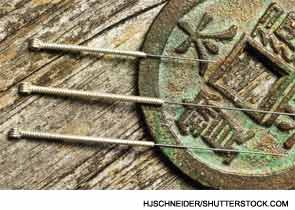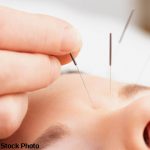
Pain and functional impairment are hallmarks of rheumatoid arthritis (RA). Given the complexity and cost of the therapeutic armamentarium used in RA, nonpharmacological therapies are becoming increasingly attractive. Recently, complementary and alternative medicine therapies for arthritis have been heavily advertised with broad, attractive claims. Clinical trials and observational studies have provided encouraging evidence that acupuncture, mind–body therapy, and Tibetan medicine have some benefits for patients with RA. This overview synthesizes the current body of knowledge on the therapeutic benefits of several types of complementary and alternative medicine approaches to relieving pain and other symptoms of RA to better inform clinical decision making for our patients.
In the past two decades, the literature has consistently recognized the potential therapeutic benefits of Tai Chi mind–body exercise for chronic conditions.
Acupuncture for RA
Originating in China more than 3,000 years ago, acupuncture is one of the most popular sensory stimulation therapies. It is an ancient technique of inserting and manipulating fine needles to stimulate specific anatomic points, also known as acupuncture points or meridian points. Acupuncture is often used for the treatment of conditions associated with pain relief and is supported by evidence of biological mechanisms. Although a recent systematic review of two trials of acupuncture on measures of disease activity in RA reported that acupuncture had no effect, another narrative review including 63 Chinese studies concluded that acupuncture was helpful in treating RA. Since many prior studies have methodological concerns that limit their interpretation, my colleagues and I performed an updated review of all currently available data to determine the efficacy of acupuncture for pain relief in patients with RA.
A comprehensive search of 10 Western and Chinese databases and reference lists was performed, and included all clinical trials with pain as an endpoint measured by tender joint count (TJC) or a pain scale. Eight studies—four placebo-controlled and four active-controlled trials—with a total of 536 patients met eligibility criteria. Average study duration was 11 weeks. The mean (standard deviation [SD]) number of acupuncture points and sessions were 11 (8) and 42 (62), respectively. Average duration of needle insertion was 24 minutes. Collectively, seven studies reported a decrease in pain for patients who received acupuncture compared with controls, and five showed a statistically significant improvement in treated patients.1-5 Compared with controls, the mean or median changes of acupuncture-decreased TJC pain ranged from 1.5 to 6.5. In addition, patients in four studies reported a significant reduction in morning stiffness (mean change –29 minutes), but the difference was not significant compared with controls.3-6 With regard to inflammatory markers, five studies observed a reduction in patients’ erythrocyte sedimentation rate (ESR) (mean –3.9 mm/hour), and three noted a reduction in patients’ levels of the C-reactive protein (CRP) (mean –2.9 mg/dl); but only one study showed a significant difference for both ESR and CRP.1-5
Because of the wide range of differences in acupuncture interventions, including dose and intensity of the needle insertion and treatment duration, an accurate quantitative estimate of treatment effects could not be ascertained. Therefore, the evidence for acupuncture’s efficacy for pain relief in patients with RA is uncertain. The lack of standardized treatment protocols suggests that future studies should focus on the optimum dose for acupuncture therapy in patients with RA, such as effective evidence-based dose/intensity, the number of acupuncture points, duration of needle insertion, frequency of acupuncture sessions, and intervention duration. It is possible that some studies, while designed correctly from a Western scientific approach, lack the correct Chinese medical approach (i.e., inappropriate dose/intensity and duration of acupuncture and insufficient expertise of acupuncturist leading to inappropriate needle insertion and manipulation techniques).

Mind–Body Therapy for RA
In the past two decades, the literature has consistently recognized the potential therapeutic benefits of Tai Chi mind–body exercise for chronic conditions. Significant improvement has been reported in balance, strength, flexibility, cardiovascular and respiratory function, mood, depression and anxiety, self-efficacy, pain reduction, and health-related quality of life in diverse Eastern and Western populations. It is clear that many of our patients with musculoskeletal disease are interested in seeking this type of exercise. Tai Chi may be beneficial to patients with RA as a result of its effects on muscle strength, stress reduction, and cardiovascular and bone health, as well as improved health-related quality of life. According to the 2007 National Health Interview Survey, around 2.5 million Americans have practiced Tai Chi, and that number is increasing. Preliminary studies showed that Tai Chi significantly improved mood and sleep disturbances, and decreased pain and fatigue in patients with RA.
My colleagues and I conducted a pilot randomized, controlled trial of 20 patients with functional class I or II RA who were randomly assigned to Tai Chi or control in twice-weekly sessions for 12 weeks.7 At the end of the trial, five out of 10 patients randomized to Tai Chi achieved an ACR20 response compared with none in the control (P=0.03). Patients who practiced Tai Chi had greater improvement in their disability index (P=0.01), depression index (P=0.003), and vitality subscale of the Medical Outcomes Study 36-item Short-Form General Health Survey (P=0.01). No adverse events were observed and no patients withdrew from the study, suggesting that Tai Chi is safe and may be beneficial for functional class I or II RA. Though other studies did not find that Tai Chi resulted in such robust improvement, a Cochrane review examining the evidence from four clinical trials suggested that it does not exacerbate symptoms of RA and may provide some benefits on lower extremity range of motion, particularly the ankle joint.
Tripterygium Wilfordii Hook F and RA
In traditional Chinese medicine, extract of the roots of Tripterygium wilfordii Hook F (TWHF) plants has been widely used to treat autoimmune and inflammatory disease. Several clinical trials have examined the therapeutic effects of TWHF in patients with RA. A prospective double-blind, placebo-controlled trial of 35 patients over 20 weeks found that four patients who took a low dose (180 mg/day) of the extract and eight patients who took a high dose (360 mg/day) met criteria for clinical response.8 The authors concluded that the ethanol/ethyl acetate extract of TWHF, at a dosage of 360 mg/day, appeared to be safe in patients with RA.
A large randomized, controlled trial of 121 patients with active RA compared the use of TWHF extract at 60 mg three times daily to sulfasalazine at 1 g twice daily. At 24 weeks, patients receiving TWHF had significantly higher ACR20, ACR50, and ACR70 response rates and saw improvement in their Health Assessment Questionnaire score.
Tibetan Five Nectar Formula Medicated Bath Therapy for RA
Tibetan Five Nectar Formula, a bath therapy, is derived from five types of plants and has been considered to have antiinflammatory and immunomodulating effects for patients with RA.
The benefits of this therapy have been reported in a number of studies. However, these studies generally are of poor quality and thus are hard to evaluate critically.
In summary, RA remains a therapeutically challenging chronic condition to control. While existing evidence regarding the use of complementary and alternative medicine modalities on RA remains limited, the data outlined above suggest that some of these treatments warrant further exploration.
Acknowledgment
This work was supported by the National Center for Complementary and Alternative Medicine of the National Institutes of Health.
Dr. Wang is director at the Center for Integrative Medicine, and an associate professor of medicine in the division of rheumatology at Tufts Medical Center, Tufts University School of Medicine in Boston.
References
- Tam LS, Leung PC, Li TK, Zhang L, Li EK. Acupuncture in the treatment of rheumatoid arthritis: A double-blind controlled pilot study. BMC Complement Altern Med. 2007;7:35.
- Zhou J, Zhu Q. Effects of acupuncture on the rheumatoid arthritis. Clin J Rheumatol. 2000;4:169-171.
- Liu G, Liu L, Luo SD, Lv M, Wang C. Therapeutic effect of electroacupuncture combined with medicine on acute rheumatoid arthritis. Chin Acupunct Moxibustion. 2003;23:712-714.
- Liu W, Liu B, Wang Y, et al. Observation on the therapeutic effect of acupuncture and moxibustin in 120 cases of rheumatoid arthritis. Chin Acupunct Moxibustion. 2003;23:577-578.
- Jiang S, Fan FY. Clinical observation on 40 cases of atrophic arthritis treated by acupuncture and moxibustion. Hunan Guiding J TCM. 2003;9:41-42.
- Cui L, Guo RX, Gen W. The effect of acupuncture on reducing the pain of patients with rheumatoid arthritis. Ann Acupunct. 2001;3:185-186.
- Wang C, Roubenoff R, Lau J, et al. Effect of Tai Chi in adults with rheumatoid arthritis. Rheumatology. 2005; 44:685-687.
- Tao X, Younger J, Fan FZ, Wang B, Lipsky PE. Benefit of an extract of Tripterygium Wilfordii Hook F in patients with rheumatoid arthritis: A double-blind, placebo-controlled study. Arthritis Rheum. 2002;46:1735-1743.
